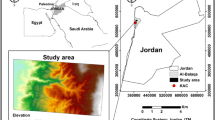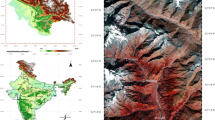Abstract
A digital elevation model (DEM) is a source of immense three dimensional data revealing topographic characteristics of any region. The performance of a DEM can be described by accuracy and the morphologic conformity. Both depend upon the quality of data set, the used production technique and the roughness of the terrain. The global DEM of ASTER (Advanced Space-borne Thermal Emission and Reflection Radiometer) was released to public utilization as free of charge on June 2009. It covers virtually overall the globe using 1 arc-second posting interval. Especially easy availability renders ASTER Global DEM (GDEM) one of the most popular and considerable global topographic data for scientific applications. From this point of view, the performance of ASTER GDEM has to be estimated for different kinds of topographies. Accordingly, six test fields from Spain (Barcelona) and Turkey (Istanbul and Zonguldak) have been preferred depending upon the terrain inclination. Thus, the advantages and disadvantages of the DEM product have been proved by means of a group of advanced performance analysis. The analyses indicate that the performance of ASTER GDEM is quite satisfying at urban areas because of flat topography. On the other hand, terrain slope has negative effect on the results. Especially steep, mountainous, forestry topographic formations and the regions which have sudden changes at the altitude have lower accuracy.


















Similar content being viewed by others
References
Büyüksalih, G., & Jacobsen, K. (2005). DEM generation and validation based on optical satellite systems. EARSeL 1st workshop on 3D-remote sensing, Porto, Portugal, 10–11st June.
Hirano, A., Welch, R., & Lang, H. (2003). Mapping from ASTER stereo image data: DEM validation and accuracy assessment. ISPRS Journal of Photogrammetry & Remote Sensing, 57, 356–370. doi:10.1016/S0924-2716(02)00164-8.
Hoja, D., Reinartz, P., Schroeder, M. (2006). Comparison of DEM generation and combination methods using high resolution optical stereo imagery and interferometric SAR data. Proceedings of the ISPRS Commission I Symposium “From Sensors to Imagery”, 36 (1), 4–6th July, Paris, Marne la Vallee (France) ISSN 1682–1777.
Jacobsen, K. (2003). DEM generation from satellite data. EARSeL workshop, 5–7th June, Ghent, Belgium, pp. 273–276.
Jacobsen, K. (2010). Comparison of ASTER GDEMs with SRTM height models. Earsel symposium, remote sensing for science, education, and natural and cultural heritage, Paris, France, 31 May–03rd June.
Kamp, U., Bolch, T., Olsenholler, J. (2003). Dem generation from ASTER satellite data for geomorphometric analysis of cerro sillajhuay. Chile/Bolivia ASPRS 2003 Annual Conference Proceedings, Anchorage, Alaska, 5–9th May.
Koch, A., & Heipke, C. (2001). Quality assessment of digital surface models derived from the Shuttle Radar Topography Mission (SRTM). IEEE 2001 International Geoscience and Remote Sensing Symposium, University of New South Wales, Sydney (Australia), 9–13th July.
Krishna, B. G., Amitabh, T. P., Srinivasan, P., Srivastava, K. (2008). Dem generation from high resolution multi-view data product. XXI. ISPRS Congress, Commission I, Volume: XXXVII, p. 1099 ff., Beijing, China, 3–11st July.
Lin, Q., Vesecky, J. F., & Zebker, H. A. (1994). Comparison of elevation derived from InSAR data with DEM over large relief terrain. International Journal of Remote Sensing, 15, 1775–1790.
Sefercik, U. G. (2006). Accuracy assessment of DEMs derived from SRTM. Master Science Thesis, Zonguldak Karaelmas University, Department of Geodesy and Photogrammetry Engineering, June.
Sefercik, U. G., & Sörgel, U. (2010). Evaluation of DEMs derived by TerraSAR-X InSAR data. Earsel symposium remote sensing for science, education, and natural and cultural heritage, Paris, France, 31 May–03rd June.
Sefercik, U. G., Bayik, C., Karakis, S., Jacobsen, K. (2011). Morphologic quality of DSMs based on optical and radar space imagery. ISPRS Hannover Workshop, Hannover, Germany, 14–17th June.
CIRSTEN (Combined Remote Sensing Natural Disaster Monitoring) web site, last visit August, 2011, “http://www.photogrammetry.ethz.ch/research/cirsten/cirsten_dem.html”
NASA (National Aeronautics and Space Administration) web site, last visit September, 2011 “http://www.nasa.gov/”
METI (Ministry of Economy, Trade and Industry) web site, last visit September, 2011, “http://www.meti.go.jp/english/”
JPL (Jet Propulsion Laboratory), California Institute of Technology, NASA web site, ASTER Mission, last visit September, 2011, “http://asterweb.jpl.nasa.gov/mission.asp”
LPDAAC (Land Processes Distributed Active Archive Center), USGS web site, last visit April, 2011 “https://lpdaac.usgs.gov/”
ERSDAC (Earth Remote Sensing Data Analysis Center), ASTER GDEM web site, last visit September, 2011 “http://www.ersdac.or.jp/GDEM/E/4.html”
USGS (United States Geological Survey), DEM accuracy standards web site, last visit August, 2011 “http://rockyweb.cr.usgs.gov/nmpstds/demstds.html”
Watanebe, K., Sefercik, U. G., Schunert, A., Sörgel, U. (2011). Evaluation of INSAR DEM from high-resolution spaceborne SAR data. ISPRS Hannover Workshop, Hannover, Germany, 14–17th June.
Yang, X., Zhang, W., Zhu, S. (2001). Accuracy assessment of ASTER GDEM ın North Shaanxi of China. Advances in cartography and GIScience, volume 2, lecture notes in geoinformation and cartography, 6(Part 6), 371–382, doi:10.1007/978-3-642-19214-2_25.
Acknowledgements
Thanks are going to NASA, METI and Land Processes Distributed Active Archive Center (LPDAAC) for their help to provide ASTER GDEM data and Institut Cartogràfic de Catalunya (ICC), Istanbul Greater Municipality and Zonguldak Municipality for reference DEMs of Barcelona, Istanbul and Zonguldak.
Author information
Authors and Affiliations
Corresponding author
About this article
Cite this article
Sefercik, U.G. Performance Estimation of Aster Global DEM Depending upon the Terrain Inclination. J Indian Soc Remote Sens 40, 565–576 (2012). https://doi.org/10.1007/s12524-012-0202-y
Received:
Accepted:
Published:
Issue Date:
DOI: https://doi.org/10.1007/s12524-012-0202-y




